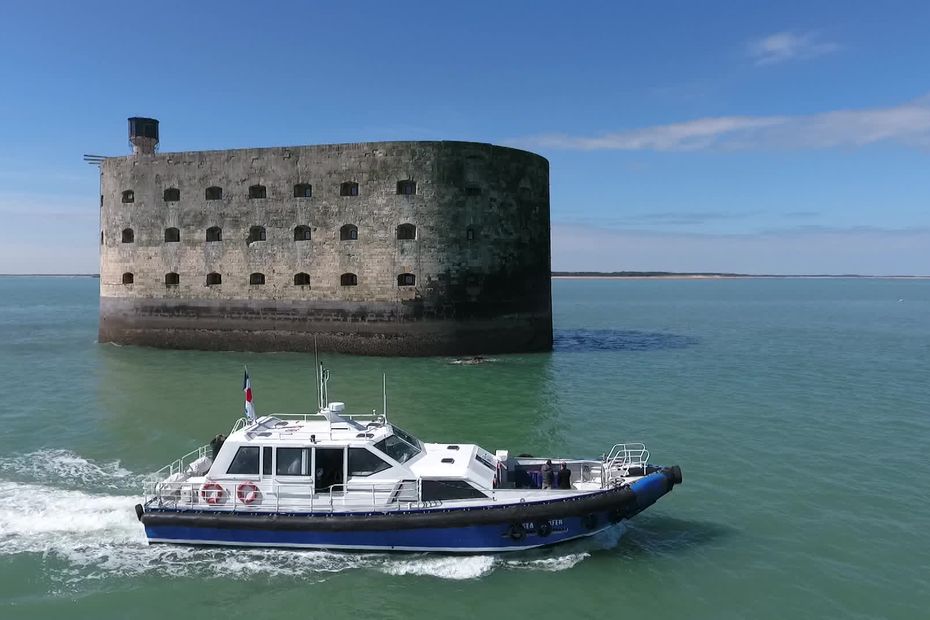Fort Boyard like new. This is the wish of Charente-Maritime, which wishes to restore the facades of the historic monument, threatened by climatic hazards. A 36 million euro project which will last three years.
“We must save Fort Boyard!” The president of the Charente-Maritime department, with these words, demonstrates her desire to preserve “this heritage treasure”. For many years, the fort, known internationally, has suffered from climatic hazards (storms, waves) and is gradually deteriorating. Unfortunately, it’s far from over. In 1989, the Department became the owner and since that date, it has regularly invested in its restoration (façade, walls, lookout, stairs, etc.).
But today, in 2024, the challenges are much bigger and different. The objective is then to restore it, to protect it and above all to safeguard it in the Charentais maritime landscape. A project which represents 36 million euros. From May 2 and until September 27, a public consultation will take place. She will inform them about the context and issues related to the safeguarding of Fort Boyard. This phase also aims to collect their opinions and answer their questions about the project, its characteristics and the conditions for its realization. These opinions will then be the subject of an assessment and will contribute to possible optimizations.
February 6, 1866 marked the end of the construction of Fort Boyard after 65 years. It served as a fort for a short time and became a prison for a short time in 1870. It was a building that required so much maintenance that it was abandoned in 1913.
It then deteriorates over the decades. The docking harbor and the spur have notably disappeared and the berm (which consolidates the walls) which surrounds the fort has considerably deteriorated. Listed as a Historic Monument in 1950, it was bought by several owners, but they did not maintain it.
It was only in 1989 that Charente-Maritime became the owner of Fort Boyard and undertook restoration work. The monument then begins its second life. A complete renovation is carried out: clearing, installation of joinery, construction of the wooden walkway on the first floor, lookout. After this major work, the famous game show “Fort Boyard” appeared on the screens and made this architectural gem known to the general public. For 20 years, from 1996 to 2016, numerous restoration works were carried out.
A risk of ruin?
These last years, investigations made it possible to identify the damage. Today, the northwest facade (the spur was then installed on this face) of the fort is more weathered than the others. It has big cracks.
Lhe composition of the monument is granite on the lower part and limestone, a softer and more fragile material on the upper parts. An analysis highlights the very pronounced damage to the berm, which has also almost disappeared on the South-West and North-East facades, those which formerly hosted the docking harbor and the spur. What remains of the berm has numerous cavities and some depressions.
The cracks do not represent a danger to the sustainability of the fort. However, the disappearance of the spur, the docking harbor and the dislocation of the berm pose more problems. Studies and the expertise of UBC Engineering have led to the conclusion that if nothing is done to protect the building from currents and swells, Fort Boyard will inevitably become a ruin.
A major project
Following these conclusions, the Department’s project consists of restoring the protective works of the fort, with current technologies and materials, without losing its original spirit. In detail, the work will focus on the reconstruction of a new protective spur against swell and sea currents on the North-West face, the most faithful restitution of a docking harbour, a “small port”, on the South-East face, and the repair of the already existing berm and the protective blocks to avoid the effects of erosion.
Beyond ensuring the protection and sustainability of the building, this work makes it possible to restore this historic monument to its original integrity. The different stages of architectural design were presented, to the services of the Architects of Buildings of France, Historic Monuments and the DREAL (Regional Directorate for the Environment, Planning and Housing, site inspection) to arrive at a project sharing. The main structures, the spur and the docking harbor will be prefabricated in one piece and assembled on land, before being towed by sea towards the fort.
Before the restoration begins in summer 2025, it will be necessary to obtain a prefectural decree which will authorize the work, due in May 2025. The end of the project is planned for the end of 2027 or the beginning of 2028.

/regions/2024/04/19/fort-boyard-4-662286245f70f087160163.png)
/regions/2024/04/19/fissures-fort-boyard-1-66228de08f9ee218558733.jpg)